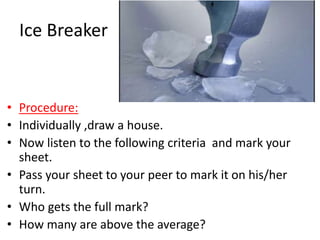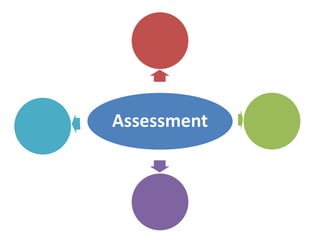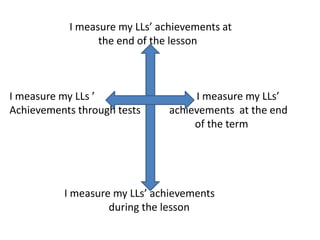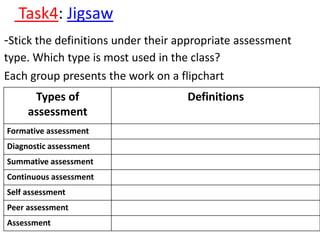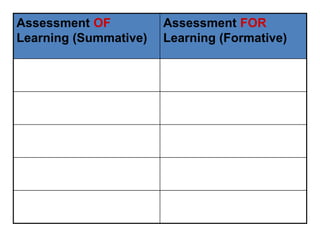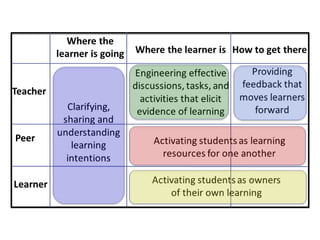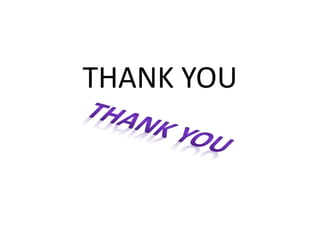Assessment Workshop.pptx
- 1. THE PEOPLE’S DEMOCRATIC REPUBLIC OF ALGERIA MINISTRY OF NATIONAL EDUCATION • A Pedagogical Morning • on: • Assessment • Ag Adghar Brahim High School • Ankouf _Tamanrasset • 14th November,2017
- 2. Ice Breaker • Procedure: • Individually ,draw a house. • Now listen to the following criteria and mark your sheet. • Pass your sheet to your peer to mark it on his/her turn. • Who gets the full mark? • How many are above the average?
- 3. • Reflect on the steps followed. What works well? What hinders? _Did you have any uncomfortable or unpleasant experiences with grading as a student? _Did you ever receive a grade that you felt was unfair? Why was it unfair? _As a teacher, have you ever had difficulty assigning a grade to a particular students’ work? Or to a particular activity? How did you resolve the problem?
- 4. Pre-Task: Give one ,take one • When you get in to your class, what is the suitable practice you do first to know about your learners’ needs? • Write one idea then move around the room to share it with your colleagues and get theirs to fill in as many boxes as you can. • Select one idea that all participants agreed on and write it on the board.
- 5. Task 1:Think,Pair, Share - Answer these questions: • Why do you assess? • When do you assess? • What do you assess? • How do you assess?
- 7. Task2: Word Cloud • Look at the word cloud on assessment in the coming slide and pick out all the terms that can be associated together then present them on a mind map .
- 10. Assessment
- 11. Task3:The Four Corners • Choose the corner representing your daily class practice when assessing your LLs’ achievements. • Justify your choice.
- 12. I measure my LLs’ achievements at the end of the lesson I measure my LLs ’ I measure my LLs’ Achievements through tests achievements at the end of the term I measure my LLs’ achievements during the lesson
- 13. Task4: Jigsaw -Stick the definitions under their appropriate assessment type. Which type is most used in the class? Each group presents the work on a flipchart Types of assessment Definitions Formative assessment Diagnostic assessment Summative assessment Continuous assessment Self assessment Peer assessment Assessment
- 14. Types of assessment: Definitions / correction Type of assessment Diagnostic assessment Continuous assessment Formative assessment Peer assessment Self- assessment Summative assessment Assessment Définitions It is a form of pre-assessment that allows a teacher to determine students' individual strengths, weaknesses, knowledge, and skills prior to instruction. It is primarily used to discover student difficulties and to guide lesson and curriculum planning. This is subjective, often carried out during normal lesson activities. Teachers observe learners carrying out tasks and make judgments on how well they are performing. Learners are assessed regularly throughout their course, to provide both teachers and learners information on what they can do and identify any areas of weaknesses. Learners provide feedback to their classmates on their work. Learners monitor their own progress and decide how well they are doing and which aspects they need to work on. .This takes place at the end of a large chunk of learning. It involves a collection of information about LLs’ attainment at the end of a course or school year through grades assignment to report achievement or failure. It is the process of gathering, interpreting, recording, and using information about pupils’ responses to an educational task and informing about the process of teaching learning in the perspective of improvement source of definitions: TKT training module
- 15. Reflect on the two pictures. What type of assessment can be identified in each picture?(AFL – AOL)
- 16. 1.
- 17. • 2
- 18. Task 5: GW • Here are some characteristics of AOL and AFL. Classify them under the correct heading:
- 19. 19 Assessment OF Learning (Summative) Assessment FOR Learning (Formative)
- 20. Assessment in the classroom: Consider the picture and do task 6
- 21. Task6: Diagram Completion Complete the diagram below with the procedure needed to assess your LLs Plannin g What do I want students to learn? Practice How will student s get there? Assessing How do I know when my students get there? Feedback + remediatio n Where are my students now?
- 23. • Task 7 :In pairs, answer the following: What tasks or strategies can be implemented in the class for both formative and summative assessment? Share your findings with your group then select the ones you agreed on and write them down.
- 24. Formative assessment tasks/ strategies Summative assessment tasks/ strategies
- 25. Formative assessment tasks Summative assessment tasks -Open ended questions - Quizzes -Summarising -Four corners -Reflection task -Think,Pair,Share - Reordering - Pair work …………… ……………. -Tests -Exams -Questionnaire -Essays -Written report - Projects - Demonstration ………….. ………….. …………… ……………….
- 26. Post Task: Effective Strategies and Tasks for Formative Assessment The following sequence of a suggested lesson plan shows the use of some assessment strategies by the teacher. T. draws 7 balloons on the board ( to be / verb / personal pronouns /possessive adjectives /prepositions / punctuation / capital letters ) and distributes flashcards on which the following words are written: Is /am /are /in /from/ at/ live/ you’re /my ? . ! , Ahmed/ Algeria/ Blida
- 27. • T. asks learners to go to the board and stick the flashcard in the right balloon • T. asks learners to sit in groups of 4 and provides them with a set of captions, • Five groups are provided with questions • Five Groups are provided with answers • Learners order the words to get correct questions and answers • A member from each group goes to the board and sticks his question • A member from the other group has to go and stick the answer ( the one who has the answer) • The learners are asked to reorder the questions and the answer to build a coherent conversation.
- 28. • On your turn, suggest strategies / tasks to assess your LLs’ speaking skill.
- 29. THANK YOU

